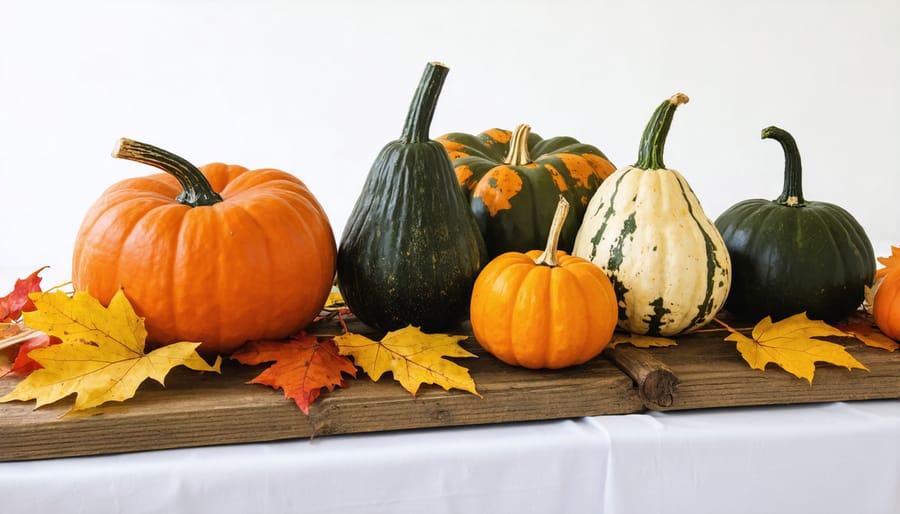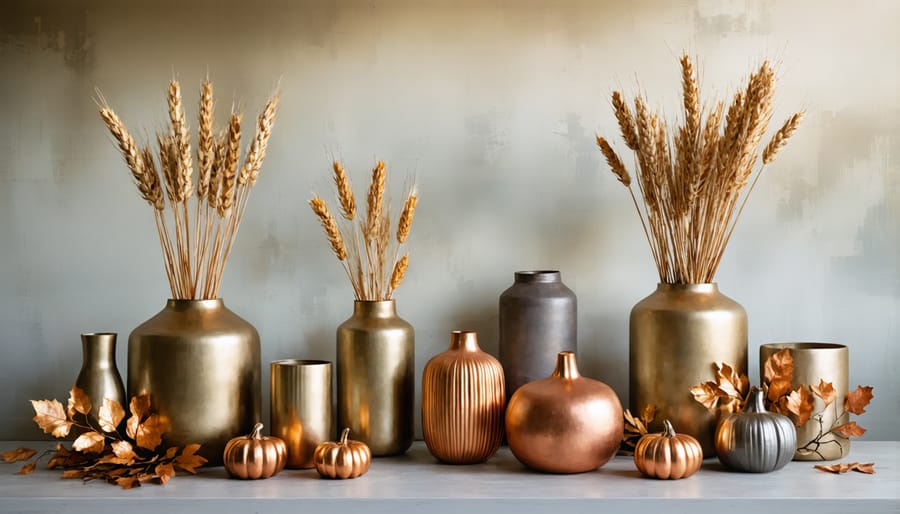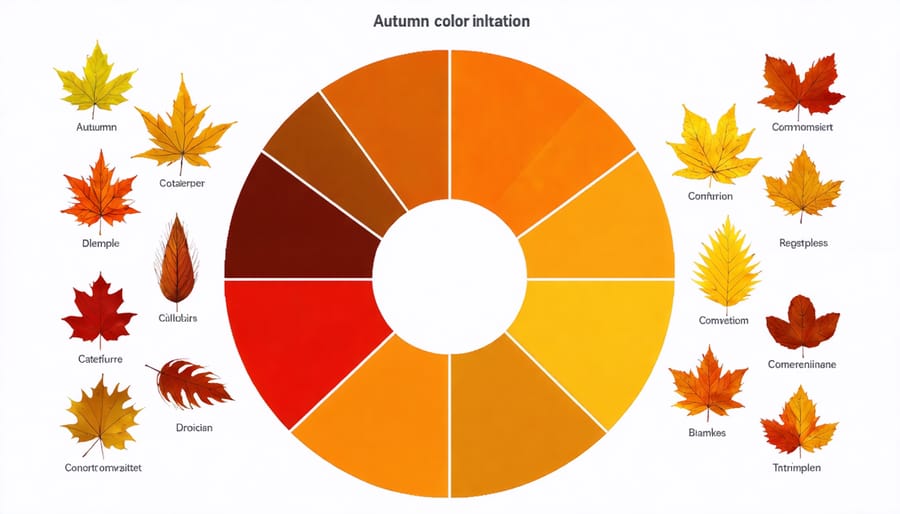Transform your dining table into a stunning autumn showcase by layering natural elements like rustic wooden chargers, metallic pumpkins, and richly-colored leaves for eye-catching seasonal table decorations. Create depth and visual interest by combining materials at varying heights—arrange tall copper candlesticks alongside medium-sized gourds and low-profile arrangements of seasonal berries and pinecones. Incorporate warm ambient lighting through flameless LED candles nestled among natural wheat stalks and dried hydrangeas, casting a golden glow across your autumnal display. Mix textures strategically by pairing smooth ceramic vessels with rough-hewn burlap runners and weathered metal accents, allowing each element to complement rather than compete. Add unexpected elements like copper-painted acorns, cinnamon sticks, and preserved moss to infuse your centerpiece with rich seasonal aromas and tactile appeal that captures autumn’s essence without overwhelming your dining space.
Natural Elements That Create Perfect Fall Centerpieces
Pumpkins and Gourds
Pumpkins and gourds are autumn’s natural showstoppers, offering endless possibilities for creating eye-catching centerpieces. Start by selecting a variety of sizes, from tiny jack-be-littles to medium sugar pumpkins, mixing both traditional orange specimens with unique varieties in white, green, and even striped patterns.
Create visual interest by arranging pumpkins at different heights – try placing smaller gourds on candlesticks or wooden blocks for an unexpected elevation. For a modern twist, paint a few pumpkins in metallic gold or copper to add glamour, or keep them natural for a more rustic feel.
Consider grouping odd numbers of pumpkins (three or five work best) and filling gaps with interesting gourds in contrasting shapes. Swan-neck gourds add graceful curves, while warty varieties bring delightful texture. For added dimension, nestle small ornamental squash around larger pumpkins and incorporate dried leaves or twigs between them.
Pro tip: Extend the life of your display by choosing firm, unblemished specimens and keeping them cool and dry. For indoor arrangements, consider using artificial pumpkins and gourds that can be stored and reused year after year.

Autumn Foliage and Branches
Nature provides the perfect materials for stunning autumn centerpieces, and the best part is they’re often free! Start by collecting fallen leaves in various colors – look for rich burgundies, vibrant oranges, and golden yellows. Choose leaves that are still fresh and pliable, as these will last longer in your arrangement.
Combine your foraged leaves with an assortment of branches and twigs. Bare branches add height and structure, while those still holding colorful leaves create natural layers. For added interest, include oak branches with acorns, maple seed pods, or pine cones.
Consider incorporating seasonal greenery like eucalyptus, which adds a subtle silver-green contrast to the warm autumn colors. Arrange your branches first as a framework, then weave in larger leaves, finishing with smaller elements for detail. Spray your arrangement lightly with clear craft sealant to preserve the leaves’ colors and prevent them from becoming brittle.
Pro tip: Place branches in warm water for an hour before arranging to make them more flexible and easier to work with.
Harvest Fruits and Botanicals
Nature’s bounty provides the perfect materials for stunning autumn centerpieces. Start by gathering fresh apples and pears in rich fall colors like deep red, golden yellow, and russet brown. Arrange them in a vintage wooden bowl or weathered basket, mixing different sizes and varieties for visual interest. Add clusters of dark purple elderberries or bright orange sea buckthorn for pops of color and texture.
Dried flowers bring a romantic, vintage touch to your arrangement. Consider incorporating dried hydrangeas, which naturally take on beautiful autumn hues, along with preserved oak leaves and wheat stalks. For a whimsical touch, scatter small crabapples or rosehips around the base of your centerpiece.
Pro tip: To extend the life of your fruit-based centerpiece, choose slightly underripe fruits and keep them away from direct sunlight. You can also mix in high-quality faux fruits with real botanical elements for a longer-lasting display that maintains its fresh appeal throughout the season.
DIY Centerpiece Arrangements
Rustic Farmhouse Style
Embrace the warmth and charm of countryside living with rustic farmhouse-style centerpieces that create a cozy atmosphere perfect for autumn gatherings. Start with a weathered wooden box or antique crate as your base, which instantly adds character to your table setting. Fill it with a mix of natural elements in muted earth tones – think wheat stalks, dried corn husks, and preserved oak leaves.
Layer your arrangement with vintage mason jars in varying heights, filling them with cream-colored candles or seasonal blooms in soft oranges and dusty browns. Incorporate raw elements like unfinished wood slices as platforms for smaller decorative items, such as mini white pumpkins or pinecones collected from your backyard.
For added texture, weave burlap ribbon throughout the arrangement or use it as a table runner underneath. Consider adding metallic accents in aged copper or brushed brass to catch the warm candlelight. Vintage farmhouse finds like old milk bottles or enamelware can serve as unexpected vessels for dried florals.
Keep the overall palette subdued with whites, creams, and warm neutrals, allowing the natural textures to take center stage. Remember to vary heights and depths while maintaining a casual, collected-over-time feel that’s signature to farmhouse style. This relaxed approach ensures your centerpiece feels both intentional and effortlessly elegant.
Elegant Modern Designs
For a sophisticated take on autumn decor, embrace modern design elements while maintaining the season’s warmth. Start with a sleek, metallic vessel – copper, brass, or brushed gold works beautifully – and fill it with a carefully curated selection of fall foliage. Consider incorporating spray-painted branches in metallic silver or gold, which add height and drama while maintaining clean lines.
Layer your centerpiece with geometric elements, such as metallic orbs or contemporary candleholders in varying heights. White or gray pumpkins offer an elegant alternative to traditional orange ones, especially when arranged alongside mercury glass votives and metallic pine cones. For added sophistication, include white-painted dried seedpods or bleached wheat stalks.
Expert Tip: Create visual interest by playing with different textures while maintaining a consistent color palette. Try combining smooth metallic surfaces with rough natural elements like dried artichokes or seedpods.
Consider incorporating modern elements like concrete vessels or matte black containers filled with dried eucalyptus and preserved oak leaves. Add LED string lights wrapped in clear glass cylinders for a subtle glow that doesn’t compromise the clean aesthetic. For maximum impact, arrange elements in odd numbers and maintain asymmetrical balance while keeping the overall design intentionally minimal.
Remember to keep the arrangement low enough for comfortable dinner conversation – around 12 inches is ideal for most dining tables. This modern approach creates an eye-catching focal point that feels both seasonal and sophisticated.

Traditional Harvest Theme
The cornucopia, also known as the horn of plenty, stands as an enduring symbol of autumn abundance and makes for a stunning centerpiece that captures the essence of traditional harvest celebrations. Start with a wicker cornucopia basket as your base, available at most craft stores during the fall season. Line it with dried moss or raffia to create a natural foundation for your arrangement.
Fill your cornucopia with a mix of artificial and real elements: mini pumpkins, gourds, Indian corn, pine cones, and seasonal fruits like apples and pears. For added authenticity, incorporate wheat stalks, dried corn husks, and autumn leaves, allowing them to spill naturally from the horn’s opening. Position larger items at the back of the arrangement, gradually transitioning to smaller elements toward the front.
To elevate your traditional harvest display, consider adding vintage elements like antique candlesticks or weathered wooden bowls alongside your cornucopia. Create layers by placing your arrangement on a burlap table runner and surrounding it with scattered acorns and smaller decorative pumpkins. For evening ambiance, integrate battery-operated flameless candles in amber hues.
Expert tip: Spray artificial fruits and vegetables with a light coating of matte-finish sealer to reduce their shine and create a more realistic appearance. Refresh real elements weekly to maintain the arrangement’s appeal throughout the season.
Styling Tips and Tricks
Color Coordination
When it comes to creating stunning autumn centerpieces, understanding color psychology in design can help you create more impactful arrangements. The key is to work with nature’s autumnal palette while maintaining visual harmony.
Start with a base of warm oranges, deep reds, and golden yellows – the classic fall colors that mirror changing leaves. Layer these with rich browns and touches of deep green to ground your arrangement. For a modern twist, incorporate deep purples or burgundy, which add sophistication while staying true to the seasonal theme.
Create depth by using different shades of the same color family. For example, pair bright orange pumpkins with softer coral-toned flowers, or combine deep crimson leaves with lighter pink-red berries. This variation adds visual interest without overwhelming the eye.
Consider your home’s existing decor when selecting colors. If your dining room features cool tones, warm them up gradually with amber and bronze elements. For warm-toned spaces, lean into rich burgundies and deep oranges to enhance the cozy atmosphere.
Remember the rule of thirds when combining colors: choose a dominant color (about 60% of the arrangement), a secondary color (30%), and an accent color (10%) to create a balanced composition. This approach ensures your centerpiece looks intentional rather than chaotic, while still capturing autumn’s natural beauty.

Scale and Proportion
When creating your autumn centerpiece, proper scaling and proportion are crucial for achieving a visually pleasing arrangement. A general rule of thumb is to keep your centerpiece height at around one and a half times the width of your base. For dining tables, ensure your arrangement doesn’t exceed 12-14 inches in height to allow comfortable conversation across the table.
Layer your elements by size, starting with larger items like pumpkins or gourds as anchor pieces. Medium-sized elements such as pine cones or fruit should fill the middle layer, while smaller items like acorns or berries can add delicate detail to the upper portions. This creates a natural visual progression that draws the eye upward.
Consider your table size when planning your centerpiece. For round tables, aim for arrangements that are roughly one-third the table’s diameter. On rectangular tables, you can either create one substantial centerpiece or arrange several smaller groupings along the table’s length. Leave at least 18 inches of clear space on either side of your centerpiece for place settings and serving dishes.
For asymmetrical arrangements, maintain balance by grouping heavier elements on one side and compensating with height or volume on the other. Remember that odd numbers of items typically create more interesting and natural-looking displays than even numbers. Start with groups of three or five when arranging similar items for the most appealing visual impact.
Care and Maintenance
Keeping your autumn centerpiece looking fresh and vibrant throughout the season requires a bit of care and attention. For natural elements like pumpkins and gourds, store them in a cool, dry place when not in use, and regularly check for any signs of softening or decay. A light coating of clear craft sealant can help preserve their appearance and extend their lifespan.
For dried flowers and foliage, avoid placing them in direct sunlight to prevent fading. Periodically dust your arrangements using a soft feather duster or compressed air on the lowest setting. If you’re incorporating fresh flowers, change the water every 2-3 days and trim the stems at an angle to promote better water absorption.
Natural pine cones and acorns can be refreshed with a gentle wash in warm, soapy water – just be sure to dry them thoroughly before returning them to your display. For fabric elements like burlap or ribbons, spot clean as needed and store flat when not in use to prevent creasing.
If your centerpiece includes candles, always trim the wicks to ¼ inch before lighting, and never leave them burning unattended. Place protective coasters under candle holders to prevent wax from damaging your table surface.
To maintain the arrangement’s shape, rotate your centerpiece every few days so all sides receive equal exposure to light and heat. Consider creating two identical centerpieces so you can alternate them, giving each time to “rest” and maintain its freshness longer. When storing seasonal pieces, wrap delicate items in tissue paper and keep them in a sealed container to protect them from dust and moisture until next year.
Creating your own autumn centerpiece is a rewarding way to bring the season’s warmth and beauty into your home. Whether you’ve chosen to work with natural elements like pumpkins and pinecones, or opted for artificial materials that can be used year after year, the possibilities are endless. Remember that the best centerpieces reflect your personal style while complementing your space.
Don’t be afraid to experiment with different combinations of materials, colors, and textures. Start with a simple design and build upon it as you gain confidence. The key is to maintain balance while creating visual interest through varying heights and seasonal elements.
Keep in mind that your centerpiece can evolve throughout the season. Swap out elements as needed, refresh natural materials, and adjust your design to suit different occasions. With these ideas and techniques as your foundation, you can create stunning autumn displays that will impress your guests and bring joy to your daily life.
So gather your materials, let your creativity flow, and embrace the spirit of fall as you craft your perfect autumn centerpiece. After all, the most beautiful decorations are those made with care and personal touch.
